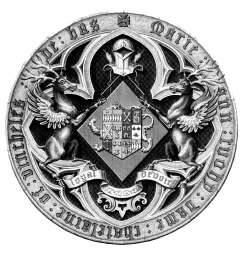The de Carterets were for centuries the leading family in the island. They have provided nine Lieut-Governors, 15 Bailiffs, nine Attorney-Generals, and at least 48 Jurats.
Family rights
When a de Carteret was Jurat he claimed the right to sit next to the Bailiff. When a Governor died, the Seigneur of St Ouen took command of the troops, until a new Governor was appointed. Elizabeth I granted the family Sark "in reward of the many services received by herself and her royal ancestors from this family", and Charles II granted them Alderney.
They came from Carteret, the little town on the Cotentin coast almost opposite Jersey, where they were Lords of the Manor. Their property at St Ouen was at first only an outlying corner of larger estates in Normandy. Wace, in his list of those who fought at Hastings, mentions Onfrai and Maugier De Cartrai, of whom Maugier was newly made a knight.
The Doomsday Book shows that the latter was rewarded with estates in Somerset. We then for a time chiefly hear of the family through their benefactions to the Abbey of Mont St Michel. Onfrai's son Renaud, who followed Geoffroi de Bouillon on the First Crusade, and was present at the taking of Jerusalem in 1099, gave to the Abbey in 1125 the Church of St Germain at Carteret and land belonging to that Church in Jersey.
This gift his son Philippe, "moved by the counsel of evil men", tried in 1135 to recall, but "at length by the inspiration of God he repented", and not only confirmed the gift, but added "two plots of ground in Jersey outside his house". This shows that the family had now a house on the island.
By another charter he gave the Abbey the tithes of St Ouen and an acre of land to build a barn to receive them. In 1156 Robert de Torigny, the famous Abbot of Mont St Michel, visited Jersey, and Philippe de Carteret, his kinsman, gave to the Abbey the Church of St Ouen and the Chapel of St Mary de Lecq in the same parish. In return the Abbey promised that one of the family could always be received as a monk of St Michel.
When King John lost Normandy in 1204, Renaud, Philippe's son, had to choose between the French and English allegiance. He adhered to John, though this meant the loss of all his Norman possessions. But the suspicious King kept Renaud's son Philippe for many years as a hostage.
Jersey officials
The interests of the family now centred on Jersey. Renaud held Mont Orgueil against the French in 1338-9; Geoffroi was Dean, and died in 1368; Renaud in 1356 helped to recapture Castle Cornet; Philippe in 1468 helped to recover Mont Orgueil from Maulevrier; another Philippe in 1494 was saved from a vindictive Governor by his wife's dash to England; Helier, the Bailiff, in 1528 defied Wolsey in the Star Chamber; another Helier in 1565 recolonized Sark; Edouard in 1542 was defendant in a famous murder case; Sir Philippe was the Royalist leader in the Civil War; [[Philippe de Carteret (1620-1662)|Another Sir Philippe was Bailiff in 1661-62; yet another Philippe held the same office from 1682-93; Sir Edouard was Bailiff from 1694-98; Charles de Carteret|Sir Charles]] was Bailiff from 1702-15.
With Sir Charles the direct male line of the de Carterets of St Ouen's Manor ended. But meanwhile younger sons had acquired manors and established branches of the family elsewhere in the island. In 1488 the childless Catherine de Vinchelis gave Vinchelez de Haut Manor to her godson, Richard De Carteret. His grandson Jeanwas the bitter opponent of the Paulets.
Younger sons of this line acquired the Manors of La Hague (St Peter) and La Hougue (Grouville). From La Hague came Francois Parliamentary Commissioner, and Philippe, Cromwell's Judge-Advocate.
From La Hougue Philippe Governor of New Jersey. In 1601 Amice de Carteret a cadet of St Ouen, acquired by marriage Trinity Manor. From him descended Josue de Carteret, Sir Edouard Usher of the Black Rod; Circumnavigator Philip de Carteret and Sir Philippe de Carteret Silvester, Captain RN.
The Carterets who dropped the ‘de’ were descendants of Elie, another cadet of St Ouen. Jerripedia includes biographies of Sir George Carteret, Governor and Bailiff, Sir Philippe, friend of Pepys; James, New Jersey rebel; John, Lord Carteret and Robert, Lord Carteret
Abbey burials
Eight de Carterets are buried in Westminster Abbey, some in the North Aisle, some in Henry VII's Chapel. Other Fiefs which at various times were held by de Carterets are:— Meleches (1306-1442 and again 1643-95), Longueville (1382-1480), La Houguette (1600-1703), St Clair (1600-1713), Rozel (1601-1711), La Hougue Dirvaut (1609-1699), Avranches (1650-1745), Morville (1650-1780, La Hougue Boete (1662-1730), Vinchelez de Bas (1664-1826).
A Fief, partly in St Peter, St Brelade and St Ouen, is called Luce de Carteret. Luce was a daughter of Geoffroi De Carteret, Seigneur of Meleches, and her estate was confiscated by the Crown, because during the Hundred Years War she married a Frenchman.
There is also a Fief de la Fille de Carteret at St Saviour, and a Court record of 1539 mentions a manor of La Fille de Carteret at St Martin. There were also important branches of this family at St Brelade, Grouville, and St Helier.

